
The History of Birkenhead Transport
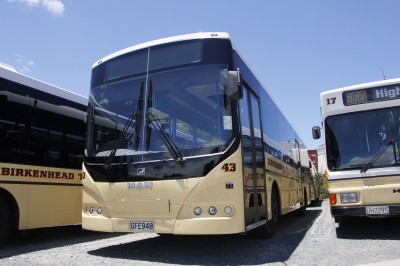
Since its inception, it was privately owned and operated by the Inwards family and as one of Auckland's oldest bus companies, it's 86 years of service was a testament to the North Shore's growth and rich heritage.
The Inwards family of 4 generations are proud of the companies many achievements and deeply appreciate to loyalty given to us by the community throughout the years.
A short history of Birkenhead Transport Ltd.

Caption: A Birkenhead Bus photographed in Highbury in 1918 waiting to pick up Troops on their return from World War I.
THE EARLY DAYS
During the depression years of the early 1930s there were two bus companies in Birkenhead - one was a co-operative of Blue Star and Marine Suburbs, and the other was the original company that was named Birkenhead Transport. In 1932 Charles Winchester Inwards, an Englishman who had arrived in New Zealand in 1919 took the advice of a friend and rode around the area on his pushbike buying shares in Birkenhead Transport from the local residents. What started as a small shareholding in the company grew rapidly and by the end of the year he had become the major shareholder which led to him taking over as Manager in December 1933.
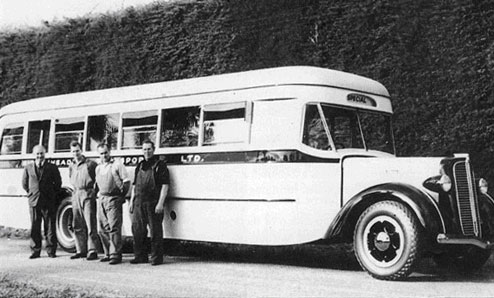
Caption: 20th October, 1938. Charlie Inwards, Ralph and Harry Shepherd, and Bert Wells (the Company mechanic) and No 9 bus, a Stewart built by Ralph Shepherd. Photographer unknown. (Inwards Collection).
A NEW ERA
Being the astute businessman that he was, Charles soon set about buying the remainder of the shares and also those in the other companies and by 1936 had built a bus depot at Verrans Corner for his new enlarged company.
The company remained in the same premises throughout the years although the depot and yard are now many times bigger than the original. During the pre-war years the fleet was updated with a number of buses with some bodies being built locally in Birkdale by the Shepherd brothers. Most of the buses at that time were built on truck chassis such as Morris, Stewart and Diamond T. The services in those pre harbour bridge days mainly serviced the ferries and ran from Birkenhead Wharf to Beach Haven, Birkdale, Highbury and Pupuke Road.
World War II
The advent of World War Two saw passenger numbers increase as petrol became scarce which resulted in an increase in services but growth was limited due to petrol rationing for bus companies and the shortage of manpower as many of the males in the district had joined the military and were based overseas. Military work also became part of the timetable with scheduled trips for both military and civilian workers to the Devonport Naval Base, Kauri Point Ammunition Depot and Beach Haven Wharf where there was a connection to the Air Force ferry across to Hobsonville. Most of these services were to continue for some years after the war and well into the 1960s.
Post War
The post war years saw New Zealand in a period of prosperity as Britain clamoured for our meat and wool products, and money flowed into the country. In 1944 a company called Ingham and Donahoe was purchased which resulted in the addition of 3 buses and a service from Birkenhead Wharf to the top of the Albany Hill. During 1952 the company branched out from its original services as a ferry feeder and pioneered a new service to Takapuna from Highbury. One of the main reasons for the new route was the continued expansion of the Chelsea Sugar Works and the need for more workers to be brought into the area daily, and in fact the sugar company originally subsidised the service. One of the social services that the company provided in the area at this time was the delivery of medicines from the chemist at Highbury to the Birkdale and Beach Haven areas. The chemist, Mr Brown, would give the package to a bus driver at Highbury with instructions as to which bus stop the customer would be waiting at and the driver would deliver it as requested.
The Auckland Harbour Bridge
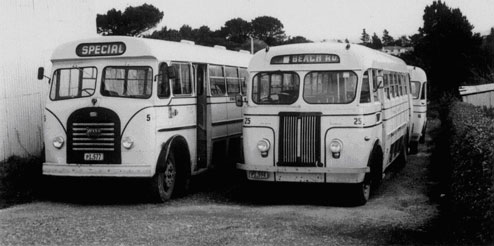
Caption: Seddon and Mack buses at the depot as part of the expanded fleet after the opening of the Auckland Harbour Bridge. (Peter Trevor photo)
The opening of the Auckland Harbour Bridge in 1959 completely changed the character of the North Shore and the company was basically reborn as a new entity. Instead of a 30 minute ferry trip the North Shore was now just a five minute drive away from downtown Auckland City. The resulting growth in the population of the area north of the bridge was unprecedented with the once quiet rural farming areas now becoming home to thousands as new subdivisions were developed.
The opening of the bridge saw Birkenhead Transport increase in size literally overnight with 9 buses working the services on the Friday prior to the official opening and 23 on the road the following Monday. The company purchased a number of second-hand Mack buses from New Zealand Railways Road Services in order to build up the fleet, before later concentrating on British built Bedfords. Interestingly the Macks were the last second-hand buses purchased by the company and for the last 50 years all additional front-line buses have been bought brand new.
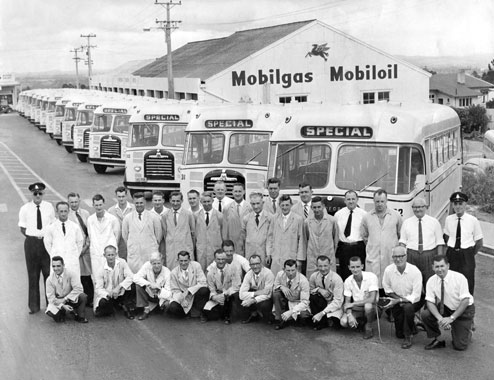
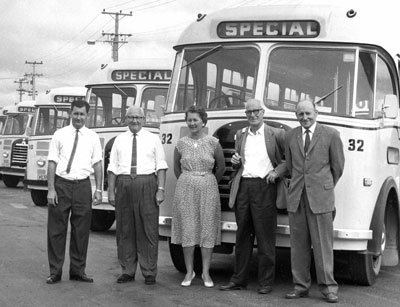
Caption: Staff and Directors of Birkenhead Transport Ltd in front of line up of Bedford Buses in November 1960
The initial timetable across the bridge had a half hourly City service at peak times, but within a very short time this proved inadequate and was increased to a 20 minute frequency, where with few exceptions it remains today. Early in 1960 discussions took place with North Shore Transport, the other North Shore bus company, to rationalise some of the services on the North Shore. One of the outcomes of this transfer of services was that Birkenhead Transport was licensed to uplift and set down City passengers in Onewa Road (the main arterial route from the Birkenhead area to the harbour bridge) which until then had been forbidden by their licence. As one can imagine, the original restrictions on Onewa Road passengers were obviously illogical as well as being inefficient and confusing to the public. The ultimate result of this change was another rapid increase in the size of the fleet to 33 buses.
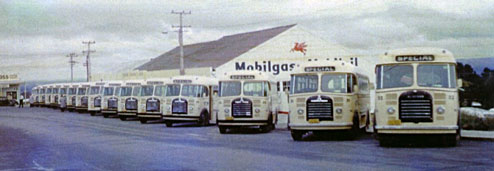
Caption: Line up of Bedford buses outside the depot at Verrans Corner in November 1960. (Kell family collection)
Pensioner Fares INTRODUCED - A New Zealand First
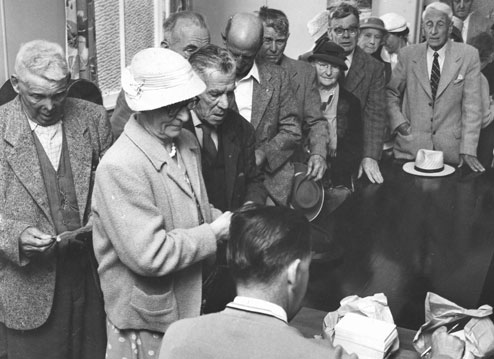 In 1961 the company became the first bus company in New Zealand to introduce pensioner fares. The idea originated from a scheme that Charles had seen during a visit to Scotland and as the company was making a good profit due to the increased patronage it was decided to give something back to the community. The first day of issue saw the office inundated with residents wanting to uplift their new pass, and although they were valid for all services it was requested that they not be used at peak times.
In 1961 the company became the first bus company in New Zealand to introduce pensioner fares. The idea originated from a scheme that Charles had seen during a visit to Scotland and as the company was making a good profit due to the increased patronage it was decided to give something back to the community. The first day of issue saw the office inundated with residents wanting to uplift their new pass, and although they were valid for all services it was requested that they not be used at peak times.
Growth and ConSOLIDATION
The rapid population growth of the North Shore continued through until the 1980’s and during this time the company was to the forefront in supplying services to many of the new suburbs that sprung up in their area.
During the early 1970’s the company fleet was composed completely of British Bedford vehicles but by the end of the decade the British motor industry had almost disappeared. As a result the Japanese Isuzu and Hino buses began to appear in the fleet and they were joined by a number of Volvos during the 1980’s. The advent of large numbers of Japanese used car imports in New Zealand saw the company going through a period of consolidation which lasted through until the mid 1990’s. Around this time the low floor MAN vehicles started to join the fleet and they were followed from early in the new millennium by the super low floor buses which compose a large part of the fleet today.
Birkenhead Transport in 2021
In the final years, the fleet largely composed of super low floor and low floor MAN buses, both 2 and 3 axle, and the company served mainly the western side of the North Shore, linking it with Auckland City, Newmarket, Ponsonby, Albany and Takapuna. Ironically over the last few years, services once again were reinstated to Birkenhead Wharf, the place where the company services had their roots. School services and charters were always been a part of the operation and remained a solid part of the business, with a small number of specialised charter vehicles included in the fleet.
Over the years the company built up a solid reputation for an efficient and safe service with clean reliable buses. Upon selling to Richies the company operated almost 70 vehicles from its original site at Verrans Corner and the management was in the capable hands of the third and fourth generations of the family.
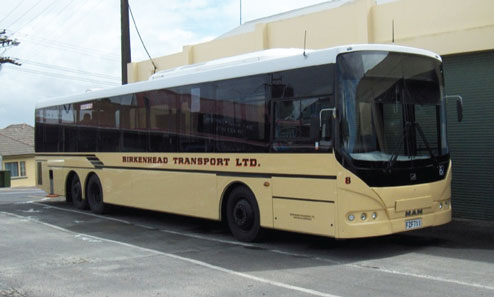
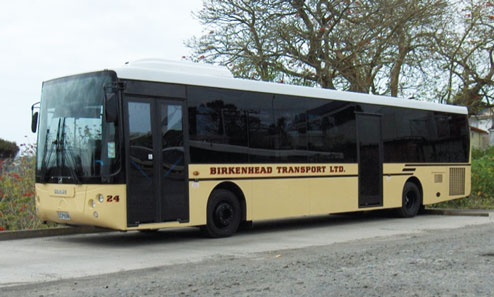
Caption: Two new MAN buses introduced into service with the company during 2011. (Ivan Prince photos)